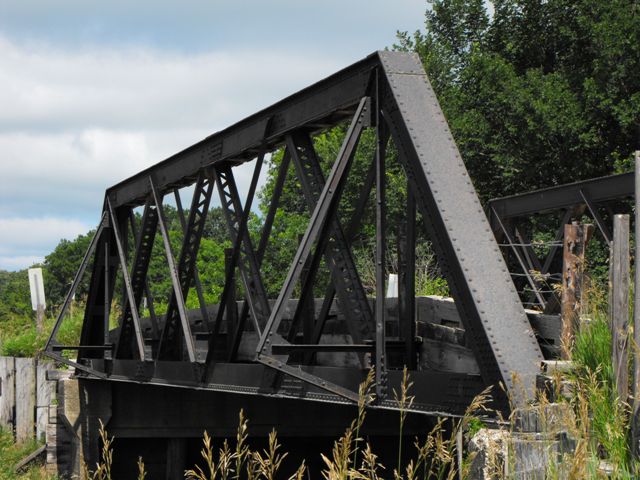We Recommend:
Bach Steel - Experts at historic truss bridge restoration.
220th Street Bridge
Iowa Bridge Number 342800

Primary Photographer(s): Nathan Holth and Rick McOmber
Bridge Documented: July 1, 2009
Rural: Webster County, Iowa: United States
1917
76.0 Feet (23.2 Meters)
78.0 Feet (23.8 Meters)
21 Feet (6.4 Meters)
1 Main Span(s)
342800

View Information About HSR Ratings
Bridge Documentation
This six panel truss bridge is a traditionally composed riveted truss bridge in Iowa. It conforms to a standard railroad design plan and a number of bridges similar in design to this one remain in Iowa, although the exact size and configuration varies from bridge to bridge making each bridge unique in some way.
This particular bridge has a unique history uncovered by John Marvig. This span was built in 1889 by the Minneapolis & St. Louis Railroad as one of two approach spans to a swing bridge at Carver, Minnesota. That bridge was replaced in 1917, and the two truss spans were reused as overpasses. It is not clear if this was the north or south approach, but one span ended up nearby in Minnesota, where it served until 2003. The other ended up here, where it appears to still be in good condition. Work for the erection was completed by the Minneapolis Steel Construction Company, also known as the Minneapolis Steel & Machinery Company. As part of the work, the original floor was cut out, and a new floor added.
At the very least, the best representative examples of standard plan truss bridges such as this one should be highlighted for preservation to retain a record of this period in history. Longer spans, multi-span examples, and unaltered examples should receive preservation priority.
In reality however, the majority of these bridges are fully capable of being rehabilitated for continued rural vehicular use and there is no reason to even consider the demolition of these bridges whether highly noteworthy or not. Many of Iowa's truss bridges are on rural dirt roads that have not been exposed to the extremely corrosive de-icing salt that bridges in other states have suffered from. As a result, they retain a comparatively high degree of structural integrity due to a striking lack of pack rust and section loss. In addition, these bridges were built with a higher quality of materials and construction than any modern bridge (contrary to what AASHTO would have you believe). These truss bridges are much more beautiful than any modern bridge. They contribute to the Iowa landscape in a positive manner and are an asset to the state.
View Archived National Bridge Inventory Report - Has Additional Details and Evaluation
Often, when a highway crosses a railroad, the railroad company was still responsible for the design and construction of a bridge to form a grade separation, as opposed to having the road owner design and construct the bridge. Such bridges tend to display unusual design features because as highway bridges they are often lighter weight bridges than bridges built to carry trains, while still displaying a railroad company thinking in terms of bridge design. Surviving examples tend to be significant and worthy of preservation, and the 220th Street Bridge is no exception. The unusual bridge follows a Howe truss configuration whose counter members make it also look like a double-intersection Warren. The description of the bridge as a Howe as opposed to a Double-Warren is made on the basis that the upward-center facing diagonals are much more substantial than their counters. The bridge is an example of a rare truss type, and an example of a railroad-designed highway bridge.
![]()
Photo Galleries and Videos: 220th Street Bridge
Bridge Photo-Documentation
Original / Full Size PhotosA collection of overview and detail photos. This gallery offers photos in the highest available resolution and file size in a touch-friendly popup viewer.
Alternatively, Browse Without Using Viewer
![]()
Bridge Photo-Documentation
Mobile Optimized PhotosA collection of overview and detail photos. This gallery features data-friendly, fast-loading photos in a touch-friendly popup viewer.
Alternatively, Browse Without Using Viewer
![]()
Maps and Links: 220th Street Bridge
Coordinates (Latitude, Longitude):
Search For Additional Bridge Listings:
Bridgehunter.com: View listed bridges within 0.5 miles (0.8 kilometers) of this bridge.
Bridgehunter.com: View listed bridges within 10 miles (16 kilometers) of this bridge.
Additional Maps:
Google Streetview (If Available)
GeoHack (Additional Links and Coordinates)
Apple Maps (Via DuckDuckGo Search)
Apple Maps (Apple devices only)
Android: Open Location In Your Map or GPS App
Flickr Gallery (Find Nearby Photos)
Wikimedia Commons (Find Nearby Photos)
Directions Via Sygic For Android
Directions Via Sygic For iOS and Android Dolphin Browser
USGS National Map (United States Only)
Historical USGS Topo Maps (United States Only)
Historic Aerials (United States Only)
CalTopo Maps (United States Only)

